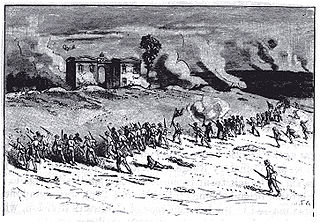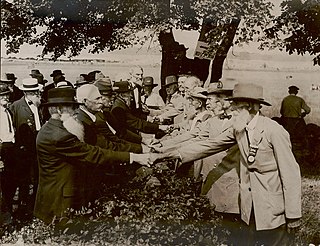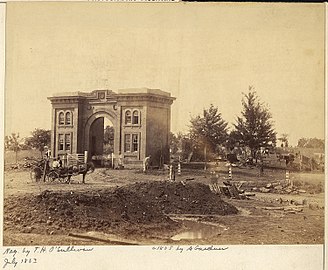
Gettysburg is a borough in and the county seat of Adams County, Pennsylvania, United States. As of the 2020 census, the borough had a population of 7,106 people.

Gettysburg National Cemetery is a United States national cemetery in Gettysburg, Pennsylvania created for Union casualties from the Battle of Gettysburg in the American Civil War. The Battle of Gettysburg, which was fought between July 1 to 3, 1863, resulted in the largest number of casualties of any Civil War battle but also was considered the war's turning point, leading ultimately to the Union victory.

The Gettysburg Battlefield is the area of the July 1–3, 1863, military engagements of the Battle of Gettysburg within and around the borough of Gettysburg, Pennsylvania. Locations of military engagements extend from the 4-acre (1.6 ha) site of the first shot at Knoxlyn Ridge on the west of the borough, to East Cavalry Field on the east. A military engagement prior to the battle was conducted at the Gettysburg Railroad trestle over Rock Creek, which was burned on June 27.

Cemetery Hill is a landform on the Gettysburg Battlefield that was the scene of fighting each day of the Battle of Gettysburg. The northernmost part of the Army of the Potomac defensive "fish-hook" line, the hill is gently sloped and provided a site for American Civil War artillery.

Culp's Hill, which is about 3⁄4 mi (1,200 m) south of the center of Gettysburg, Pennsylvania, played a prominent role in the Battle of Gettysburg. It consists of two rounded peaks, separated by a narrow saddle. Its heavily wooded higher peak is 630 ft (190 m) above sea level. The lower peak is about 100 feet shorter than its companion. The eastern slope descends to Rock Creek, about 160 feet lower in elevation, and the western slope is to a saddle with Stevens Knoll with a summit 100 ft (30 m) lower than the main Culp's Hill summit. The hill was owned in 1863 by farmer Henry Culp and was publicized as "Culp's Hill" by October 31, 1865.
David McConaughy was a noted attorney, state senator, cemetery president, and civic leader in Gettysburg, Pennsylvania and a part-time intelligence officer for the Union Army during the American Civil War. He was a driving force behind the creation of the Gettysburg National Cemetery following the Battle of Gettysburg. He also led early efforts to preserve the Gettysburg Battlefield for future generations.

Rock Creek is an 18.9-mile-long (30.4 km) tributary of the Monocacy River in south-central Pennsylvania and serves as the border between Cumberland and Mount Joy townships. Rock Creek was used by the Underground Railroad and flows near several Gettysburg Battlefield sites, including Culp's Hill, the Benner Hill artillery location, and Barlow Knoll.

Evergreen Cemetery – formerly called Citizen's Cemetery and Ever Green Cemetery – is a historic 29.12 acre rural cemetery located just outside Gettysburg Borough, in Cumberland Township, Adams County, Pennsylvania, United States. It is part of Gettysburg Battlefield Historic District, and is surrounded by Gettysburg National Military Park and Soldiers' National Cemetery.

Pennsylvania Route 97 is one of two Pennsylvania state highways that carries the PA 97 designation; the other PA 97 is in Erie County. This southern PA 97, known for most of its length as Baltimore Pike, runs 9.363 miles (15.068 km) from the Maryland state line near Littlestown, where the highway continues as Maryland Route 97, northwest to U.S. Route 15 near Gettysburg. PA 97 connects Gettysburg and Littlestown in southeastern Adams County. The highway also links those communities with Westminster and Baltimore. From PA 97's northern end, Baltimore Pike continues toward Gettysburg as State Route 2035 through the Gettysburg Battlefield Historic District, where it provides access to the Gettysburg Museum and Visitor Center.
The "Gibraltar Brigade" was a famed infantry brigade within the Army of the Potomac during the American Civil War. Recognizing its tenacity in combat at the Battle of Antietam, Brigadier General William French assigned the nickname as a comparison to the steadfastness of the Rock of Gibraltar. At Antietam the 8th Ohio Infantry, 14th Indiana Infantry, 7th West Virginia Infantry and 132nd Pennsylvania comprised the Brigade. The 4th Ohio Infantry Regiment was forced to miss the Maryland Campaign due to regiment-wide sickness but was otherwise a consistent member of the Brigade. It served in many of the major battles of the Eastern Theater.

The 1913 Gettysburg reunion was a Gettysburg Battlefield encampment of American Civil War veterans for the Battle of Gettysburg's 50th anniversary. The June 29–July 4 gathering of 53,407 veterans was the largest ever Civil War veteran reunion. All honorably discharged veterans in the Grand Army of the Republic and the United Confederate Veterans were invited, and veterans from 46 of the 48 states attended, all but Nevada and Wyoming.

The Gettysburg Battlefield Historic District is a district of contributing properties and over 1000 historic contributing structures and 315 historic buildings, located in Adams County, Pennsylvania. The district was added to the National Register of Historic Places on March 19, 1975. Most of the contributing elements of the Gettysburg Battlefield are on the protected federal property within the smaller Gettysburg National Military Park.
Plum Run is a Pennsylvania stream flowing southward from the Gettysburg Battlefield between the Gettys-Black Divide on the east and on the west, the drainage divide for Pitzer Run, Biesecker Run, Willoughby Run, and Marsh Creek.
United States v. Gettysburg Electric Ry. Co., 160 U.S. 668 (1896), was a case to prevent trolley operations on the Gettysburg Battlefield. The dispute began in August 1891 when the Gettysburg Battlefield Memorial Association's board approved attorney Samuel Swope's motion to deny trolley right-of-way along GBMA roads. Despite the 1896 US Supreme Court ruling that the railway could be seized for historic preservation, as well as earlier legislative efforts to appropriate federal acquisition funds, create a War Department commission, and form the Gettysburg National Military Park; the trolley continued operations until obsolete in 1916.

Barlow is a populated place between the Gettysburg Battlefield and the Mason–Dixon line in Adams County, Pennsylvania, United States, situated at the intersection of Rock Creek and Pennsylvania Route 134. North of the creek on the road summit is the principal facility of the rural community: the 1939 community hall at the Barlow Volunteer Fire Company fire station. The hall is a Cumberland Township polling place and was used by Mamie and Dwight D. Eisenhower after purchasing their nearby farm. Horner's Mill was the site of an 1861 Union Civil War encampment, and the covered bridge was used by the II Corps and General George G. Meade en route to the 1863 Battle of Gettysburg.

Schmucker Hall is an American Civil War site listed on the National Register of Historic Places in Adams County, Pennsylvania, that was constructed as the original Gettysburg Theological Seminary building. Used as both a Union and Confederate hospital during the 1863 Battle of Gettysburg, the facility served as the seminary's main building from 1832 to 1895, then as a dedicated dormitory for students until 1951. In 1960, it was leased by the Adams County Historical Society. Beginning in 2006, the Historical Society, along with the Seminary Seminary Ridge Historic Preservation Foundation, rehabilitated the building for adaptive reuse as the Seminary Ridge Museum. The Adams County Historical Society moved into the nearby Wolf House on the seminary campus preceding the renovation. In 2013, on the 150th anniversary of the battle, the Seminary, the Adams County Historical Society and the Seminary Ridge Historic Preservation Foundation opened the building as the Seminary Ridge Museum. The Museum houses displays about many different aspects of the battle, the seminary, the town, and the civil war, and the struggle among faith groups over slavery, as well as offering tours of the cupola. The exhibit and museum have earned international, national and regional awards and the rehabilitation achieved LEED Certification in 2013.

McPherson Ridge is a landform used for military engagements during the 1863 Battle of Gettysburg, when the I Corps of the Union Army had a headquarters on the ridge and was defeated by the Confederate division of Major General Henry Heth. The ridge has terrain above ~530 ft (160 m) and is almost entirely a federally protected area except for township portions at the southern end and along Pennsylvania Route 116, including a PennDOT facility. The northern end is a slight topographic saddle point on the west edge of Oak Ridge, and summit areas above 560 ft (170 m) include 4 on/near the Lincoln Highway, a broader summit south of the Fairfield Road, and the larger plateau at the northern saddle.

East Cemetery Hill is a Gettysburg Battlefield landform used for the battle of East Cemetery Hill during the 1863 Battle of Gettysburg, Second Day. Located on the east of Gettysburg's Baltimore Street and the Baltimore Pike which meet on the hill, the hill is a northeast spur, and the east slope, of Cemetery Hill. The hill has numerous postwar battlefield monuments, as well as artillery lunettes remaining from the Battle of Gettysburg. Slocum Avenue is on the south slope, while Wainwright Avenue is near the east base.
Elizabeth Möser Thorn was an American cemetery caretaker who served as the caretaker of Evergreen Cemetery in Adams County, Pennsylvania, while her husband was serving in the Union Army. While pregnant, Thorn buried approximately one hundred soldiers who had died at the Battle of Gettysburg in 1863.





















